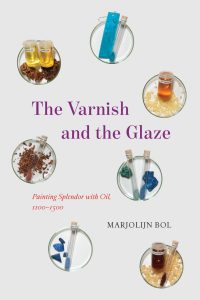Read an Excerpt from “The Varnish and the Glaze” by Marjolijn Bol
Panel painters in both the middle ages and the fifteenth century created works that evoke the luster of precious stones, the sheen of polished gold and silver, and the colorful radiance of stained glass. Yet their approaches to rendering these materials were markedly different. In her forthcoming book, Marjolijn Bol explores some of the reasons behind this radical transformation by telling the history of the two oil painting techniques used to depict everything that glistens and glows—varnish and glaze.
For more than a century after his death, the fifteenth-century painter Jan van Eyck was widely credited with inventing varnish and oil paint. Once this was revealed to be a myth, the verisimilitude of his work was attributed instead to a new translucent painting technique: glaze. Bol, however, argues that, rather than being a fifteenth-century refinement, varnishing and glazing began centuries before. In The Varnish and the Glaze, Bol draws from an extensive body of recipes to piece together how varnishes and glazes were first developed as part of the medieval art of material mimesis. Artisans embellished metalwork and wood with varnishes and glazes to imitate gold and gems, and infused rock crystal with oil, resin, and colorants to imitate more precious minerals. Natural historians, influenced by medieval artists’ understanding of refraction and reflection, developed theories about gems, their creation, and their optical qualities. In this excerpt, Bol discusses recipes for imitation emeralds.
Coloring Crystals: Oil and the Imitation of Precious Stones
Medieval scholars studied the genesis of gems through craft practices resembling the natural processes or through practices of material mimesis designed to create an optical substitute for precious stones. Hildegard von Bingen’s gems were made like foam on hot metal and Albertus Magnus’s clear gems were made in a manner similar to the way artisans make glass. Another method used since ancient times to imitate gems is closely related to the glazing technique that is the subject of this book. It may, in part, even explain the origin of the technique.
The earliest surviving reference to this practice is about making an imitation emerald. The passage can be found in the Epistles, or Moral Letters to Lucilius (Ad Lucilium epistulae morales) of the Roman philosopher Seneca the Younger (1 BC to AD 65). Seneca writes that the pre-Socratic philosopher Democritus of Abdera (460–370 BC) discovered how a calculus (pebble) could be transformed into zmaragdum (emerald) by boiling it. This method, Seneca points out, was still practiced in his own time on colored stones, which are “amenable to this treatment.” A similar practice used for imitating precious stones is mentioned in Pliny the Elder’s encyclopedia. He writes that the Indians have found a way to stain rock crystals to make them look like more expensive jewels. Such methods for making imitation gemstones were allegedly so convincing that Pliny complains that “there is considerable difficulty in distinguishing genuine stones from false; the more so, as there has been discovered a method of transforming genuine stones of one kind into false stones of another.” Isidore of Seville similarly writes about how convincing fake smaragdi could be and laments the abundance of such practices of deception:
As a substitute for that most precious stone, the emerald [smaragdus], some people dye glass with skill [vitrum arte inficiun], and its false greenness deceives [ falsa viriditas] the eyes with a certain subtlety, to the point that there is no one who may test it and demonstrate that it is false [quoadusque non est qui probet simulatum et arguat]. It is the same with other matters in one way or another, for there is no mortal life free from deception.
Considering the negative light in which the encyclopedic writers regard the practice of imitating gemstones, it is perhaps not surprising that most lapidaries do not discuss the specifics involved in making these imitations. Pliny does not consider it appropriate even to mention the names of the authorities on the matter:
There are treatises by authorities, whom I at least shall not deign to mention by name, describing how by means of dyestuffs emeralds [smaragdum] and other transparent [tralucentes] colored gems are made from rock crystal. . . . And there is no other trickery that is practiced against society with greater profit [neque enim est ulla fraus vitae lucrosior].
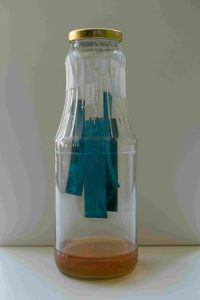
It has been suggested that an echo of the contents of the treatises on gemstone imitation that Pliny refers to here may have been preserved in the so-called Stockholm Papyrus (Papyrus Graecus Holmiensis). This document, among the earliest testaments to the Greek alchemical tradition, may have been copied as a funerary gift about AD 200–300, but it is believed to have had a much older core. The papyrus contains a variety of recipes for making alloys and dyeing textiles, and more than seventy recipes for imitating precious stones using less precious materials, including emerald (more than twenty recipes), ruby, beryl, amethyst, and sunstone. The recipes are various, but most involve “corroding” or “opening up” a transparent mineral so that it becomes receptive to the color added in the next step. For the emerald, the coloring substance is always the pigment verdigris, finely ground and mixed with oil, resin, or vinegar. The Stockholm Papyrus includes a separate instruction on how to make this pigment. In a recipe titled “Preparing Verdigris for Emerald,” the green pigment is made by suspending clean copper plates covered with oil above strong vinegar. (see figure 1)
Preparing Verdigris for Emerald
Clean a well-made sheet of Cyprian copper by means of pumice stone and water, dry, and smear it very lightly with a very little oil. Spread it out and tie a cord around it. Then hang it in cask with sharp vinegar so that it does not touch the vinegar, and carefully close the cask so no evaporation takes place. Now, if you put it in in the morning, then scrape off the verdigris carefully in the evening; but if you put it in in the evening, then scrape it off in the morning and suspend it again until the sheet becomes used up. However, as often as you scrape it off again, smear the sheet with oil as explained previously. The vinegar is [thus rendered] unfit for use.
The pigment verdigris, a copper salt known today as “copper green,” has special material and optical properties that make it particularly suitable for imitating translucent green stones. Ground with oil or resin, verdigris not only has the potential to approach the deep green hues of the emerald, it also can transmit light so as to approach its clarity. Verdigris is the only relatively stable green pigment known at the time that has a refractive index closely matching that of oil, resin, and crystal. This means that when verdigris is ground with such a binding medium and then used to coat the crystal, light can pass through while reflecting back a green hue similar to that of the emerald. (compare figures 1-3)
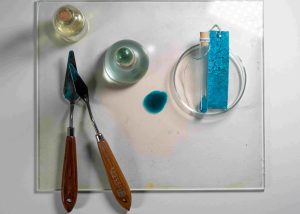
In addition, when verdigris is mixed with hot oil or resin or both, it dissolves. When a pigment is dissolved in its medium its refractive index becomes irrelevant (because it is now a “solution” without particles). The result is a perfectly translucent paint with great color saturation. That verdigris dissolves in resin (and in vinegar), makes it suitable for another method of producing imitation gems described in the papyrus: quench-cracking crystals to give them a green color. In one of the recipes for preparing such a quench-cracked emerald, the Stockholm Papyrus explains how a mixture of verdigris, celandine (Chelidonium majus L., a yellow to orange dye made the from roots, stems, and leaves of this plant, also used to color textiles), and “scythian black” (?), have to be pulverized and mixed with “liquid resin”:
Preparation of Emerald
Take pure pyrites or rock crystal and make the composition in the following way:
Verdigris, 2 drachmas; celandine, 1 drachma; Scythian black, 3 drachmas; liquid resin, which one holds in the mouth, as much as necessary. Pulverize the dry materials, mix the resin with them, and set it aside. Take liquid alum, pour water on it so it becomes very watery, and preserve it in a clay vessel. Heat the stone in an earthen vessel and cool it in the alum. Heat the stone and put it in the above-named composition. However, if you desire that it should be greener, then again mix pulverized verdigris with it.
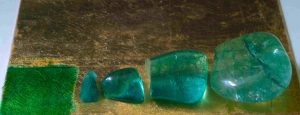
The second mixture described in the recipe, made of “liquid alum” with water, is used to quench the minerals after they have been heated in an earthen vessel. This causes a quick change in temperature that would have cracked the stone without breaking it, causing internal fractures reaching up to its surface (see figure 4).
According to the recipe, the stone should then be heated again and submerged in the first verdigris-resin solution. It is not entirely clear whether this green liquid is heated with the stones or whether they are again quenched in it, but when we consider that the stones have to take up the resin, which is quite viscous when cold, it seems likely that the resin would at least have been kept warm. When heat is applied the now fractured mineral opens up again, and through capillary action the solution of resin and copper green can penetrate the stone (see figure 3). If copper green would not dissolve in resin, the stone would have enclosed the oil while filtering out the pigment particles before they could enter the microscopic cracks.
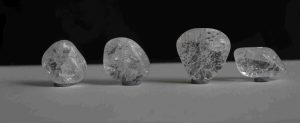
Verdigris is indeed the only pigment for coloring transparent minerals mentioned in the papyrus; the other colors are all true dyestuffs; that is, they will form a solution with the liquid they are immersed in. The papyrus mentions the red dye alkanet derived from the root of Alkanna lehmannii Tineo (formerly known as Alkanna tinctoria (L.) Tausch) and the red dye kermes derived from the bodies of female Kermes vermilio Planchon (a scale insect) for imitating translucent red stones. For imitating translucent blue stones on crystal the papyrus mentions the blue dye indigo obtained from various plants such as dyer’s woad, Isatis tinctoria L. (Brassicaceae), and from indigo, Indigofera tinctoria L. These same dyes are also mentioned in the papyrus’s recipes for dyeing textiles. It is therefore possible that the practice of coloring transparent minerals was related to, or even derived from, early technologies for making fibers receptive to dyes. The recipes for dyeing cloth are various as well, but the basic procedure involves cleaning the wool of grease and dirt before mordanting it with salts of aluminum (alum), iron, or copper. Acting as a bridge, these metallic salts ensure that the dyestuff can form a permanent chemical bond with the textile fiber. This mordanting step in dyeing cloth is therefore quite similar to “opening” up or “etching” precious stones with alum, as we have seen in the recipes for making imitation gems out of rock crystal. Even though it is not entirely clear in these recipes how alum would have helped with coloring quartz, it may have been used because it was known for its ability to “lock” in color in other materials, especially textiles.
Ultimately, the role of verdigris in imitating emeralds led natural philosophers to believe that emeralds and copper green were related substances. Albertus Magnus, for example, explains the genesis of emeralds from the pigment verdigris: “Emeralds occur in veins of copper, which gives the gems their perspicuousness [perspicuo] because it has not yet actually become copper—for the rust of copper is green” (quia rubiginis aeris habet viriditatem quod in venis aeris). The translucent emerald was thus thought to grow from verdigris or, as Albertus Magnus describes the pigment, from the “rust of copper.” An earlier Arabic source, the treatise on stones by the Persian Muslim scholar and polymath Al-Beruni (AD 973–1048), shows that Albert’s theory was already in existence before he wrote his mineralogical treatise. Al-Beruni includes a similar yet more critical stance on the idea that emeralds and copper are related substances. He writes that according to the Persian physician Rhazes (AD 854–925) emeralds and verdigris must be related because the color of the emerald is like that of verdigris. However, Al-Beruni adds the note that this can be accepted only if emeralds are found in copper mines, not in gold mines. Al-Beruni was right; only those gems that were considered the lesser species of emeralds, malachite in particular, were found in copper mines. In the West, the theory that emeralds were generated from copper was nevertheless persistent and can be found in numerous mineralogical treatises in subsequent centuries. More than two hundred years after Albert wrote his book on minerals, the Italian metallurgist Vannoccio Biringuccio (ca. 1480 to ca. 1539), while questioning various other ancient theories about the emerald, is still certain about its origin in copper: “It must be believed that all these strange things [emeralds], wherever they may come from, are colored by the virtue and power of minerals of copper [tenti per virtu & potētia dele miniere del rame].”
The previous theory likely persisted because of the various artisanal practices that used verdigris and copper to imitate the color and clarity of emeralds. We have seen that besides coloring crystals, copper was also used to produce a green color in glass to imitate emeralds, and verdigris ground with oil was used to give parchment windows the appearance of green glass. These interrelations between the materials copper, verdigris, and glass in artisanal practice came to play a prominent role in theories about the genesis of precious minerals in nature.
Adapted and excerpted from The Varnish and the Glaze by Marjolijn Bol, published by the University of Chicago Press. © 2023 by The University of Chicago. All rights reserved
Marjolijn Bol is associate professor in the Department of History and Art History at Utrecht University. She is the coeditor of The Matter of Mimesis: Studies of Mimesis and Materials in Nature, Art and Science.
The Varnish and the Glaze is available from our website or your favorite bookseller.
